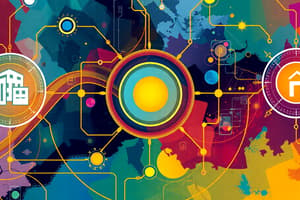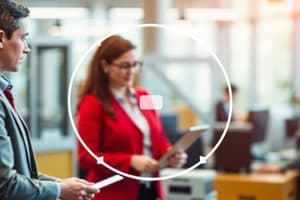Podcast
Questions and Answers
What defines disruptive IT innovations?
What defines disruptive IT innovations?
Which of the following describes structured decisions?
Which of the following describes structured decisions?
What is a primary characteristic of cloud computing services?
What is a primary characteristic of cloud computing services?
What is data redundancy?
What is data redundancy?
What role do protocols play in telecommunications network architecture?
What role do protocols play in telecommunications network architecture?
What does TCP/IP stand for and its significance?
What does TCP/IP stand for and its significance?
Which type of network connects computers within a limited area?
Which type of network connects computers within a limited area?
What is the primary purpose of sniffing in networking?
What is the primary purpose of sniffing in networking?
What is the primary function of a VPN?
What is the primary function of a VPN?
Which type of network is characterized by a large geographical area?
Which type of network is characterized by a large geographical area?
What technology is used in RFID systems to identify and track objects?
What technology is used in RFID systems to identify and track objects?
Which is a key component of effective disaster planning and recovery?
Which is a key component of effective disaster planning and recovery?
What is the primary purpose of an IS Audit?
What is the primary purpose of an IS Audit?
Which approach can be employed to manage network devices effectively?
Which approach can be employed to manage network devices effectively?
What is a characteristic of blockchain technology?
What is a characteristic of blockchain technology?
Which of the following is NOT a feature of information technology governance?
Which of the following is NOT a feature of information technology governance?
What is the primary function of FTP (File Transfer Protocol)?
What is the primary function of FTP (File Transfer Protocol)?
Which protocol is primarily used for transmitting web pages?
Which protocol is primarily used for transmitting web pages?
What does Infrastructure as a Service (IaaS) provide to businesses?
What does Infrastructure as a Service (IaaS) provide to businesses?
Which of the following best defines a vulnerability in software development?
Which of the following best defines a vulnerability in software development?
What characterizes a multi-tier server network?
What characterizes a multi-tier server network?
Which type of software is categorized as malware?
Which type of software is categorized as malware?
What does the term 'Intranet' refer to?
What does the term 'Intranet' refer to?
What is the impact of information technology on business operations?
What is the impact of information technology on business operations?
What is the primary focus of understanding business processes?
What is the primary focus of understanding business processes?
Which of the following best describes Leavitt’s organizational resistance model?
Which of the following best describes Leavitt’s organizational resistance model?
How does edge computing improve data processing?
How does edge computing improve data processing?
Which option describes utility computing?
Which option describes utility computing?
What does scalability refer to in a computing context?
What does scalability refer to in a computing context?
What function do mashups serve in web applications?
What function do mashups serve in web applications?
What is the main characteristic of SaaS (Software as a Service)?
What is the main characteristic of SaaS (Software as a Service)?
Which computing type involves hosting multiple servers in one data center?
Which computing type involves hosting multiple servers in one data center?
What process involves evaluating moral dilemmas related to information systems?
What process involves evaluating moral dilemmas related to information systems?
Which of the following best describes an ERP system’s technology infrastructure?
Which of the following best describes an ERP system’s technology infrastructure?
What is a quantum computer primarily known for?
What is a quantum computer primarily known for?
What do complementary assets refer to in the context of IT investments?
What do complementary assets refer to in the context of IT investments?
What is the primary role of user privacy aspects within information systems?
What is the primary role of user privacy aspects within information systems?
What does the Social Tool Matrix analyze?
What does the Social Tool Matrix analyze?
Which of the following describes the input of an information system?
Which of the following describes the input of an information system?
In what way do core competencies relate to information systems?
In what way do core competencies relate to information systems?
Flashcards are hidden until you start studying
Study Notes
Business Processes
- Business processes involve the flow of material, information, and knowledge to identify task performance within organizations.
- Analyzing and improving workflows enhances productivity and service delivery.
Transaction Costs
- Direct costs include hardware and software expenses.
- Indirect costs encompass training and maintenance expenses.
Leavitt’s Organizational Resistance Model
- Highlights the interdependencies among structure, technology, and people within organizations.
- Changes in one area may lead to resistance in others.
Moore’s Law
- States that the number of transistors on a chip doubles approximatelyevery two years, leading to increased computing power.
Types of Computing
- Co-location: Hosting multiple servers in a single data center.
- Edge Computing: Processes data closer to the source, minimizing latency.
- Grid Computing: A distributed model using multiple computers for complex tasks.
- Utility Computing: Computing services offered as a metered service.
Applications and Software
- Apps are designed for specific tasks across mobile and desktop platforms.
- Mashups combine data and services from different sources to create new functionalities.
- SaaS provides cloud-hosted applications accessible via the internet.
Web Services and Modality
- Web services enable integration using protocols such as XML and SOAP for seamless communication.
- Modality refers to the various methods of service or information delivery.
Scalability and Expandability
- Scalability is the ability to increase system capacity to handle growing workloads.
- Expandability allows systems to be upgraded to accommodate new features.
Disruptive IT Innovations
- Technologies that significantly change or replace existing industries, often creating new markets.
Current Technology Trends
- Key areas such as AI, cloud computing, and IoT are influencing business operations and growth.
Data Management Issues
- Data redundancy is unnecessary data duplication, while inconsistency arises when duplicate entries do not match.
- Structured decisions are routine and follow established processes, while unstructured decisions require judgment.
Network Architecture
- Protocols like TCP/IP govern data communication, ensuring interoperability in networks.
- Client/server computing involves clients requesting services from centralized servers.
Networking Fundamentals
- Local area networks (LANs) connect devices in confined areas, enabling resource sharing.
- Various signal types exist, including analog and digital, each suited for specific applications.
Security and Privacy
- Sniffing captures data packets for analysis or malicious intent.
- VPNs provide secure remote access by encrypting data transmissions.
Networking Technologies
- RFID technology uses electromagnetic fields for object identification and tracking.
- Types of networks include LAN (local), WAN (wide area), and MAN (metropolitan).
Information Systems and Audits
- IS audits evaluate data integrity, confidentiality, and regulatory compliance.
- Disaster planning prepares for and recovers from operational disruptions.
Emerging Technologies
- Blockchain is a decentralized ledger for secure transaction recording.
- Quantum computers perform complex calculations using quantum bits.
Software Protocols
- FTP is used for transferring files between clients and servers.
- HTTP facilitates web page transmission over the internet.
Business Strategy and IT Governance
- Competitive strategy involves actions to gain market advantages, either through differentiation or cost leadership.
- IT governance ensures that technology investments align with business objectives and manage risks.
Structural Elements
- Organizational features impact effectiveness, including hierarchy and communication flows.
- Complementary assets enhance IT value through skilled personnel and effective management practices.
Social Tools and User Privacy
- The Social Tool Matrix analyzes tools based on engagement and functionality.
- User privacy aspects ensure protection of personal information within information systems.
Collaboration and Value Creation
- Collaborative distribution systems improve efficiency in delivering goods and services.
- Core competencies are unique strengths enhanced by effective information systems.
Vulnerabilities and Threats
- Vulnerabilities in software arise from coding errors, posing risks for exploitation.
- Malware encompasses various malicious software designed to disrupt or damage systems.
Environmental Observations
- Strobe methodology monitors environmental conditions, utilizing technology for data collection.
Impact of Information Technology
- IT significantly influences business operations, societal interactions, and economic conditions.
Studying That Suits You
Use AI to generate personalized quizzes and flashcards to suit your learning preferences.




